#Ficus pumila
Explore tagged Tumblr posts
Text

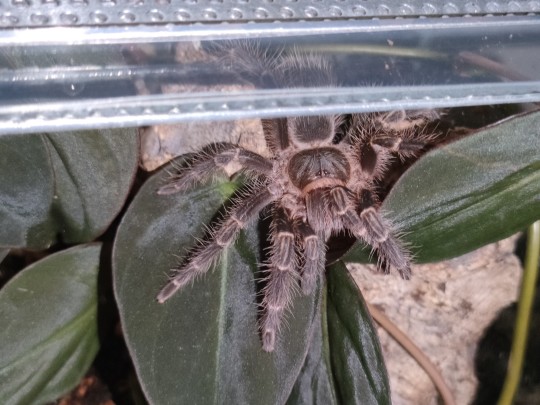




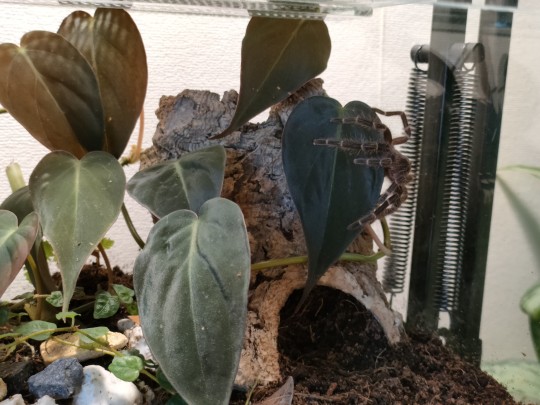


Meet my G. Pulchripes named Zephyr. I rehoused her in a new enclosure recently. There are live plants. I tried the technic of using a pot to protect the plants from her and so far it's working. She didn't pull or dig any of them out yet. It's been around 3 weeks and she dug a burrow behind the bark, covered the entrance on the ground level and uses the entrance at the top. So I guess she's arboreal now XD Good for her. The plants are doing well too. Philodendron is exploded and makes a new leaf each week. The fern in the back is worse than it started but the spider sits on it sometimes. Maybe it will bounce back.
#spider#tarantula#grammostola pulchripes#grammostola#terrarium#philodendron#philodendron micans#ficus pumila#ficus#pets
10 notes
·
View notes
Text

Lots of new growth so far this month!
1 note
·
View note
Text
The Orb has new inhabitants!

Some intentional, some unintentional. There's a small single leaf growing next to the D. capensis that I'm hoping will turn out to be a hitchhiking bladderwort. I don't have high hopes for the ficus, but I had extra, so I might as well see if it can help steal some nutrients from the algae starting to take over the moat. Worst case scenario, they'll be springtail food.
I have much higher hopes for the moss slurry I added today. In combination with the moss from the droseras' original pots waking up, it should start to look much greener very soon!
#I think I'm also gonna have to get some floating plants for the moat#once the rest of the dirt finally settles#the Orb#bog bowl#carnivorous plants#drosera#sundew#ficus pumila
1 note
·
View note
Note
Can you ramble about something from your biology field of interest for 5 to 115 minutes please? Favourite genus/species perhaps?
I did a bit of a ramble about Azolla a day ir two ago so go look at that bit i’ll do another.
So in the Ficus (figs) genus, which has over 800 species and includes the common fig, Ficus Carica which I will start off with as it is the most familiar to people. It is a small to medium sized tree native to the Mediterranean region as well as parts of Western Asia. It is drought tolerant and grows in semi arid and arid regions. The sweet, fleshy fruit of the tree warranted the cultivation of it across the region for thousands of years. It now is grown across the world. (this info relates to all ficus now) The fruit isn’t actually one fruit but an inverted inflorescence (look it up) called a Syconium. So basically a fleshy cave lined with fruits.

(fig torn in half)
On to the wasps. The cave like structure of has a small opening at the base of the fruit. All ficus are pollinated by minuscule wasps Sp. That generally fly into the fig, buzz around and pollinate it and die inside the fig and then dissolve wait its more complicated then that but I forgot so here is an article
https://www.fs.usda.gov/wildflowers/pollinators/pollinator-of-the-month/fig_wasp.shtml
Some species of figs, generally called banyans or strangler figs, start life growing as an epiphytic (growing off the ground such as in a tree) vine, due to it’s fruits being eaten by birds and defecating in leaf litter in the trees branches or at the base of the tree. As it climbs it creates a lattice of aerial roots that choke the trunk of the host tree. The vine reaches up into the canopy, smothering the light of the host tree, and the roots attach to the ground. This eventually kills the host, allowing the ficus to hijack the structure of the tree, as if the first tree never existed.

Banyans are a little different, but the terms are generally interchangeable. Banyans form large spreading trees, sometimes through strangling, and as the branches grow out they drop aerial roots. Once they hit the ground, they thicken to become whole new trunks, still attached to the main tree though the branches. It props up the brach and allows the canopy to extend extemely wide. The Great Banyan Tree in Bengal has the appearance of a forest but it is all from one tree!
There is Ficus Pumila, the climbing fig, which clings to hard surfaces very closely, you would barely know it is a fig species. I’ve heard the fruits were used as a gelstiniser in some asian cooking though. The ability to cover walls in harsh environments means they are great for greening up building and as an extension of that, urban areas. So that is cool.


My favourite ficus is the Moreton Bay Fig, native to NSW in Australia. It has large, pointed oval leaves with a glossy, dark green top and a red underside. It can behave as a strangler/banyan, but that kinda depends on it being in the warmer more humid areas for it to put down aerial roots .It also grows well standing as a tree on it’s own, thus it was planted across the globe in warm temperate climates as a large feature tree in parks. It is great for climbing due to its low, wide canopy and huge buttress roots which stabilise it.



I’ll leave it at that.
#official nature post#nature#environmentalism#ficus#figs#botany#thanks for letting me rant#10/10 would do again so please more people ask#maybe suggest a topic and I’ll say if I know shot about it or not
9 notes
·
View notes
Text
my adventure into terrariums



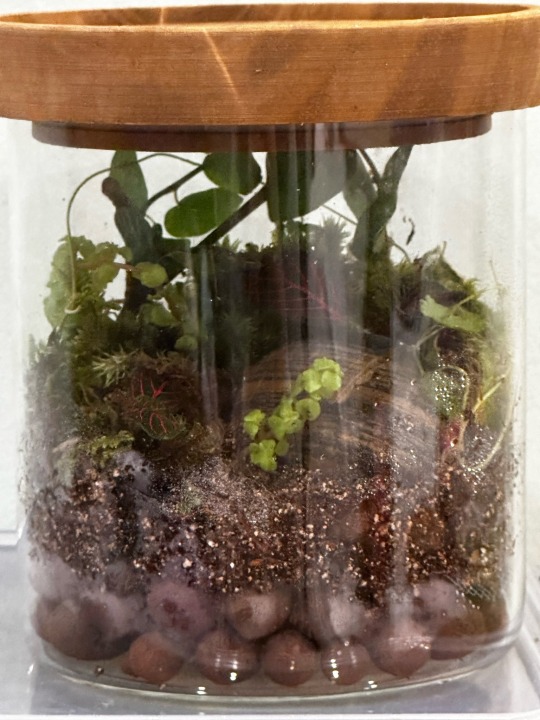
So I just recently got into terrariums and just HAD to make some. The plants I used were:
Ficus pumila, peperomia emarginella, assorted moss, red fittonia, baby tears, duckweed, and lawn marsh pennywort.
I am SO happy with how they turned out!! I learned everything from a YouTube channel called terrarium designs.
Such a fun new hobby I found :)
63 notes
·
View notes
Text
JTTW Chapter 14 Thoughts
Chapter 14 for the @journeythroughjourneytothewest Reading Group! Another nature heavy one! Potential TW: under the cut is a parasitic plant that kind of looks like yellow spiderwebbing or something similar.
Though first a little by the by as I have mentioned before I actually prefer this aspect of the German translation, which translates Xin as heart instead of mind.
Anyway it’s flower symbolism time! Wisterias in Buddhism stand for humility and reflection, which is very fitting for our monkey to be overgrown by under the mountain.
Additionally if we go with the saying ‘somebody has something coming out of his ears’ which means that someone had enough of something, the detail of those flowers growing out of Sun Wukong’s ears is even more fitting. Though I’m not sure if it’s the same in English, but that’s how the saying goes in German.
Wisterias are also very pretty and grow very abundantly which is just a gorgeous sight to behold.


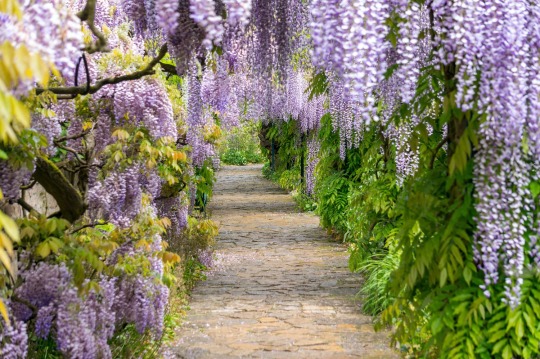
However there is actually some discrepancy found between translations about which plants grow out of his ears and growing on the mountain for that matter.
In the German translation the “creepers and vines” are actually specific plants. The first is called creeping fig or climbing fig (ficus pumila or 薜 bì), which is also the one mentioned in the J.F. Jenner translation.
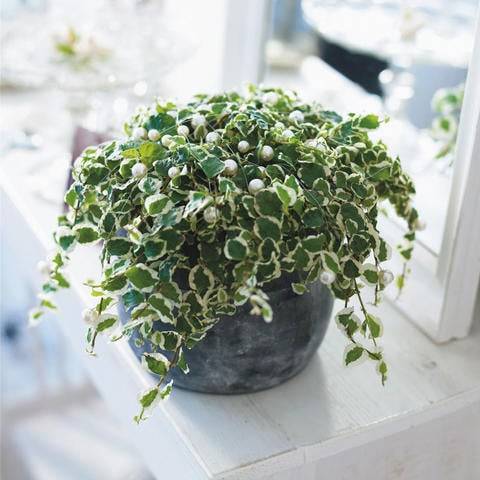
They can grow to cover entire surfaces too! Like this wall for example.

Dodder or amarbel or how I like to call them ‘forbidden spaghetti’ (cuscuta or 蘿 luó) is the second one.

They have little flowers too.

Those two plants stand for eremitic life in Chinese symbolism. As that note is citing the Chinese characters, I’m inclined to take this for the accurate translation.
Regardless both plants function equally well in terms of symbolism in my opinion.
Continuing with translation shenanigans “axe or drill” in the Anthony C. Yu translation is “axe or chisel” in both other translations, which sounds more natural to me. Though “drill” does bring to my mind a funny little picture of Tang Sanzang with a hard hat and a handheld drill trying to drill away the mountain above Sun Wukong.
Checking out the original Chinese with Google translate I’ve also come across something interesting. 斧鑿 fǔzáo when separated from the rest just gets translated to “axe + chisel”, but together with the full section it gets translated as “axe to chisel” instead. However when translated as part of the complete speech it’s just “But I don't have an axe.”
“Only when he […] saw the handsome features of Tripitaka” an early instance of Tang Sanzang looks having a greater influence on people.
Love to see Sun Wukong getting along with people!
A little side note because I just find it to be a really cute detail regarding the whole “sugar man or honey man”, in the German translation specific sweets are mentioned because they start with the same letter. I just think that’s neat.
I love when a bit of Slice of Life is sprinkled in and attention to detail is paid for everyday things, I hope we see some more in the future!
Ah, the first time Tang Sanzang falls from his horse.
I must admit that the names of the six bandits are more straightforward and easier to understand in the J.F. Jenner and German translation. For the J.F. Jenner translation specifically they are translated as “Eye−seeing Happiness, Ear−hearing Anger, Nose−smelling Love, Tongue−tasting Thought, Mind−born Desire, and Body−based Sorrow”. This also makes the reactions of them easier to understand as they are actually matched to one bandit each! “This made the bandits happy, angry, loving, thoughtful, desirous, and sorrowful respectively” as in the J.F. Jenner translation again. It barely comes across that those are matched in the Anthony C. Yu translation.
The bit about monks looking out even for insects is very sweet! Especially since I am a moth enjoyer, they are so fluffy and adorable.
Shigong’s shoe-based shenanigans made me briefly try to link it to Cinderella. Journey to the West is known for starting a bunch of tropes, so it makes sense my brain would try to link it with a lot of stuff, but Cinderella is probably not related. A humorous thing to imagine still.
Closing this post with another note on Tang Sanzang. Ohoho so our dear monk is able to lie. And right after telling Sun Wukong that a monk should not lie as well. He has flaws! Very neat, I quite like that actually. Character development will be something very interesting to keep an eye out for.
#xiyouji#journey to the west#jttw#tang sanzang#sun wukong#jttw reading group#jttw book club#wisteria#climbing fig#dodder
19 notes
·
View notes
Text


That Ficus pumila is out of control
And there's a piece of gum stuck under it smh 🙄
7 notes
·
View notes
Text

Ficus pumila 'Quercifolia'
2 notes
·
View notes
Text
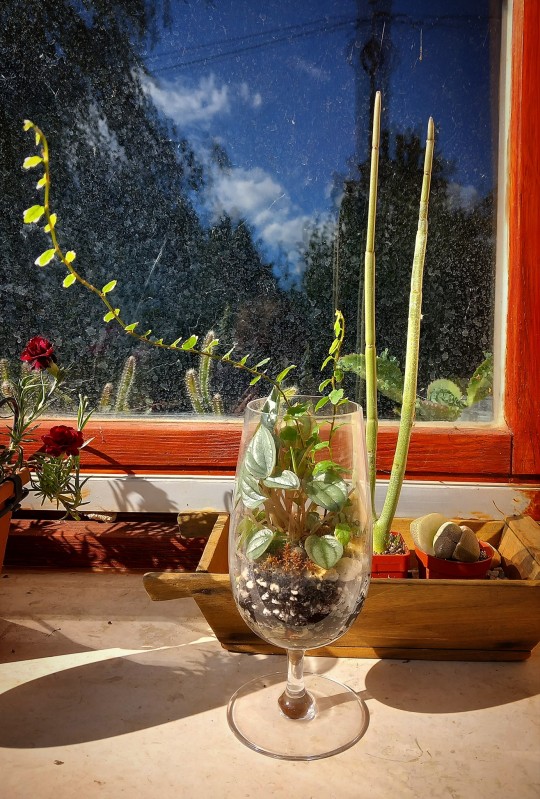

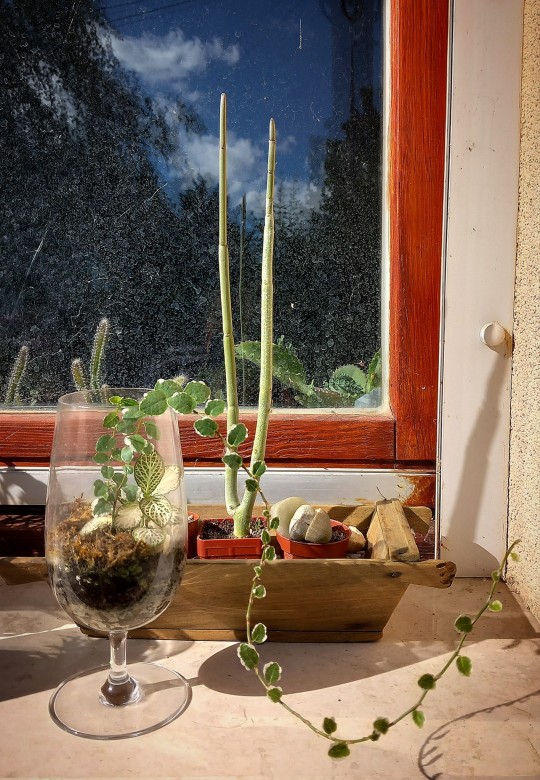
Summer cocktails
1. Peperomia caperata 'Napoli Nights' + Ficus pumila
2. Peperomia prostrata + Begonia listada
3. Ficus pumila + Fittonia albivenis
4 notes
·
View notes
Text



I kinda want to share what I'm doing. Now I'm making an enclosure for my tarantula with plants. The plan is to use a pot to protect the plants from the spider. Its the big stone like one. The small one is for the oxalis that was in one of the nursery pots for which I didn't pay. There was also a fern and a peperomia leaf. So many free plants. Tried to propagate the peperomia leaf like YouTube told me and one half decided to grow roots in the air. I thought it wasn't suppose to happen. Oh well. At least now I'm sure one of them is growing. I flipped it over, don't worry. Also oxalis has such pretty purple on the back side of the leafs, I didn't know that.
0 notes
Text

The mourning gecko viv, featuring Ficus pumila, tradescantia and I forgot the name of that fuzzy purple plant. Also lime spider plant, bamboo tubes and Hazel branches. And a piece of cholla wood.
Gonna let it settle for a bit, then move the peacock gecko into it temporarily while I redo his viv before putting him back.
Then the mourning geckos!
I'm knackered.
2 notes
·
View notes
Text
6 x 58cm Artificial Hanging Climbing Fig Plant Ficus Pumila

View On WordPress
0 notes
Text

my ficus pumila is starting to show some variegation again! might prune some of the non-variegated growth, or all of it. haven’t decided yet
#i think it’ll depend on how much variegation keeps popping up#we’ll see if he gets enough light#my plants#houseplants#ficus pumila#ficus pumila variegata#creeping fig
3 notes
·
View notes
Text


creeping fig <3
#i love my#creeping fig#so much#shes one of my faves#ficus pumila#plants#house plants#plant#plantblr#plant lover#plant mom#plantparenthood#plant collection#plant collector#plant pics#7/29/20
134 notes
·
View notes
Text

My aunt came over and fell in love with the extra pot of Ficus pumila var quercifolia that I propagated, so I gave that pot to her. And I proceeded to propagate even more pots. It's been 1 week I think? The cuttings are rooting and growing 🌱😊😊
These have officially overtaken String of Hearts as my new favourite plant cos they are even easier to grow and propagate 😍
And maybe also cos I had mealy bug infestation on all my SOH and it was so gross and I threw out many pots and I'm left with 2 variegated pots so I'm like 😵
46 notes
·
View notes
Text

A little pricey but this is the cutest mount, looks like a fairy land🌱🧚♀️
7 notes
·
View notes